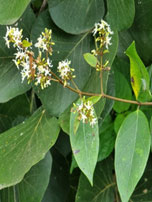Krishnasariva

Botanical Name : Ichnocarpus frutescens
Family : Lamiaceae
Names in Different Languages :
Common name : Black Creeper
Bengali : shyama lata
Gujarati : shyamlata
Hindi : dirgha-mula
Kannada : gauriballi,
Konkani : kante bhonvri, krishnasarwa
Malayalam : nannari,palvalli
Marathi : kate bhowari
Nepali : dudhe lahara
Odia : mahila
Sanskrit : krishnasariva
Tamil : utar-koti
Morphology :
Black Creeper is an evergreen woody twiners, with branches smooth or rust, velvety when young, with milky sap. Probably, because of the rust colored stems, this creeper earned the names black creeper, श्यामलता Shyamalata etc. Leaves are elliptic oblong or lance-shaped, tip pointed or tapering, base rounded or narrow, 4-10 cm long, 1.5-5 cm wide. Leaves are smooth and dark green above, and paler beneath, with 2.5-5 mm long stalks. Flowers are borne in many flowered clusters, 3-8 cm across. The stalks carrying the flowers and the flower clusters are hairy. Flowers are white, about 1 cm across. Sepals are ovate, blunt, velvety, about 1 mm long. Flower tube is about 2.5 mm long, much thickened at the mouth. Petals are 1.5 mm long, with long hairs on the margin. Follicles are solitary or paired, 10-15 x 0.5 cm, straight or curved, rusty pubescent when young. Seeds very slender, 1-2 cm long.
Flowering : August-December.
Uses :
The plant has a large number of traditional medicinal uses, including for rheumatism, asthma, cholera, and fever.
Some in vitro and rodent studies have suggested that extracts of the plant may inhibit tumors,protect liver cells from damage in acetaminophen overdose,and reduces complications of hyperlipidemia in diabetic rats.
There have been no published studies testing any of these effects in humans.